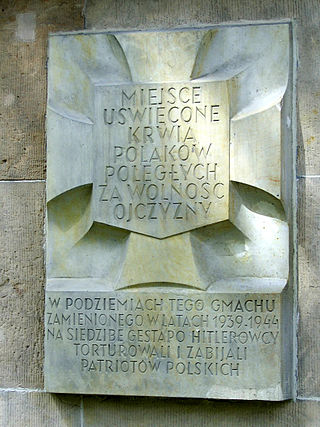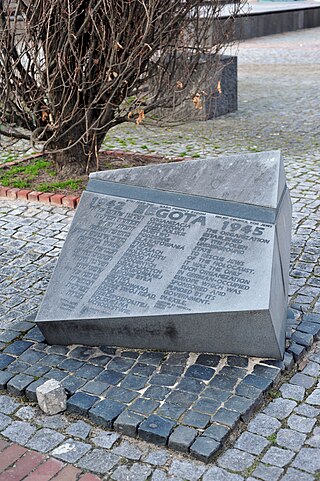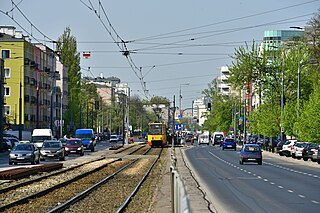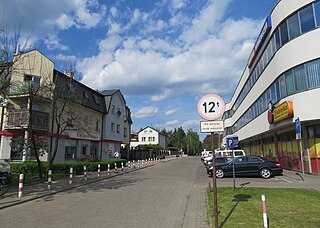
Wierzbno is a neighbourhood, and an area of the City Information System, in the city of Warsaw, Poland, located within the district of Mokotów. It is a residential area, with most of its eastern area consisting of villas and tenements, and its western area, and a portion of its eastern area, consisting of multifamily residential large panel system-buildings.

Tadeusz Żenczykowski, pseudonym Kania, Kowalik and Zawadzki was a Polish lawyer, political activist and soldier in the Armia Krajowa during World War II, taking part in the Warsaw Uprising of 1944. Immediately after the war, he was a member of the anti-communist conspiracy in Poland. In 1945, he emigrated and became a journalist and deputy chief of the Polish Section of Radio Free Europe, historian and publicist.

Ksawerów is a neighbourhood, and an area of the City Information System, in the city of Warsaw, Poland, located within the district of Mokotów. The neighbourhood mostly consists of a residential area, consisting of multifamily residential apartment buildings, and single-family detached homes.

Siekierki is a low-rise housing residential neighborhood in Warsaw, the northeastern part of the Mokotów district belonging to Lower Mokotów, adjacent to the Vistula river. The area is home to an astronomical research center of the Polish Academy of Sciences and a Marian sanctuary.

Służewiec is a neighbourhood, and an area of the City Information System, in the city of Warsaw, Poland, located within the district of Mokotów. Most of the neighbourhood consists of office buildings, which form one of the biggest complexes of office buildings in Poland, and one of the most important office centres in the city. It contains many headquarters of branches of many domestic and multinational corporations. A small portion of the neighbourhood also forms a residential area with apartment buildings.

Tomasz Marceli Szarota is a Polish historian and publicist. As a historian, his areas of expertise relate to history of World War II, and everyday life in occupied Poland, in particular, in occupied Warsaw and other occupied major European cities.

The Leszczyński Residence - also called the Prażmowski, Pastoriusa, Rautenstrauchów or Dobrycza - is a rococo-classical townhouse at 87 Krakowskie Przedmieście, in Warsaw.

Tchorek plaques are a common design of memorial plaque in Warsaw, Poland, used to commemorate places where battles or executions took place during the German occupation of the city during World War II. They are based on an original design by sculptor Karol Tchorek from 1949.

Tepper's Palace was a palace on Miodowa Street in the Polish capital of Warsaw.

The Aviator Monument is a monument in Warsaw designed by Edward Wittig in honor of Franciszek Żwirko and Stanisław Wigura, two aviation heroes of Poland. It is a reconstruction of the original monument that was unveiled in 1932 in Union of Lublin Square and destroyed in 1944. The current monument was constructed in 1967.

Tarchomin is a neighborhood of Białołęka district, in northern Warsaw, Poland.

Annopol is a neighborhood of Białołęka district in Warsaw, Poland. For the residents of Warsaw, Annopol is known for being a tram terminus, with several Warsaw tram lines stopping here, and it is also an industrial centre.

The Żegota Monument is a stone monument dedicated to the Żegota organization, which rescued Jews during the Holocaust in Poland. It is on Anielewicza Street in Warsaw in the Muranów neighborhood of Warsaw, Poland, near the Monument to the Ghetto Heroes and the POLIN Museum of the History of Polish Jews.

Frascati is a historic neighbourhood and inner-suburb in central Warsaw, the capital of Poland. The area extends eastward from the Three Crosses Square and covers the broad parkland and housing estates surrounding Frascati and Nullo streets, located between the Polish parliament building, the Warsaw Stock Exchange and the National Museum. The neighbourhood was named after the Italian city of Frascati.

Grochowska Street is a major road located in the Praga Południe district of Warsaw, Poland. Since November 1, 1925, a tram route has run along Grochowska Street. Currently trams and many bus lines connect Praga with Śródmieście, Wola, Rembertów and Wawer.

Makabi Warszawa, in English Makabi Warsaw, founded in 1915 in Warsaw, Poland was a Polish sports club founded by the Jewish Gymnastic and Sports Association "Maccabi" in Warsaw. It was the largest multi-section Jewish sports club in the Second Polish Republic.

Miedzeszyn is a neighbourhood of Wawer, a district of Warsaw, Poland. Until 1951, it was a separate village.

Jelonki, prior to 1951 known as Jelonek, is a residential neighbourhood in the city of Warsaw, Poland, located within the district of Bemowo. The City Information System divides the neighbourhood into two areas, Jelonki Północne and Jelonki Południowe.

Odolany is a neighbourhood, and an area of the City Information System, in the city of Warsaw, Poland, located within the district of Wola.

Chrzanów is a residential neighbourhood, and an area of the Municipal Information System, in the city of Warsaw, Poland, located within the district of Bemowo.






















